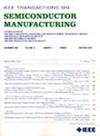Manufacturing of g-C3N4-ZnS-Doped TiO2 Nanofibers by Electrospinning and Their Application to Dye-Sensitized Solar Cell as an Additional Layer in Photoanode
IF 2.3
3区 工程技术
Q2 ENGINEERING, ELECTRICAL & ELECTRONIC
引用次数: 0
Abstract
This study aims to enhance photovoltaic performance of dye-sensitized solar cells (DSSCs) by modification of photoanode with nanofibers (NFs) as an additional layer. g-C3N4 and ZnS (CN-ZnS) were selected for the modification of TiO2 nanofibers. The g-C3N4 was synthesized using a calcination method, while the CN-ZnS was successfully prepared through a simple hydrothermal method. Subsequently, CN-ZnS/TiO2 NFs with different mixing ratios were fabricated using electrospinning technology. The synthesized material was characterized by X-ray diffraction and scanning electron microscopy. The positive impact of incorporating the additional layer on the photovoltaic performance of DSSCs was confirmed through electrochemical impedance spectroscopy, UV-vis spectroscopy, J-V characterization, and incident photon-to-current efficiency measurements. Notably, the DSSC modified with 1% CN-ZnS/TiO2 NFs achieves an efficiency of 5.44%, and it reaches an efficiency of 7.04% under low illumination (30 mW/cm2). These results suggest that CN-ZnS/TiO2 NFs are promising for enhancing the performance of DSSCs.静电纺丝制备g- c3n4 - zns掺杂TiO2纳米纤维及其在染料敏化太阳能电池中的应用
本研究旨在通过纳米纤维(NFs)作为附加层修饰光阳极来提高染料敏化太阳能电池(DSSCs)的光伏性能。选择g-C3N4和ZnS (CN-ZnS)对TiO2纳米纤维进行改性。g-C3N4采用烧结法合成,CN-ZnS采用简单的水热法制备。随后,采用静电纺丝技术制备了不同配比的CN-ZnS/TiO2 NFs。用x射线衍射和扫描电镜对合成材料进行了表征。通过电化学阻抗谱、紫外-可见光谱、J-V表征和入射光子电流效率测量,证实了添加额外层对DSSCs光伏性能的积极影响。值得注意的是,1% CN-ZnS/TiO2 NFs修饰的DSSC效率为5.44%,在低照度(30 mW/cm2)下效率为7.04%。这些结果表明,CN-ZnS/TiO2纳米颗粒有望提高DSSCs的性能。
本文章由计算机程序翻译,如有差异,请以英文原文为准。
求助全文
约1分钟内获得全文
求助全文
来源期刊

IEEE Transactions on Semiconductor Manufacturing
工程技术-工程:电子与电气
CiteScore
5.20
自引率
11.10%
发文量
101
审稿时长
3.3 months
期刊介绍:
The IEEE Transactions on Semiconductor Manufacturing addresses the challenging problems of manufacturing complex microelectronic components, especially very large scale integrated circuits (VLSI). Manufacturing these products requires precision micropatterning, precise control of materials properties, ultraclean work environments, and complex interactions of chemical, physical, electrical and mechanical processes.
 求助内容:
求助内容: 应助结果提醒方式:
应助结果提醒方式:


